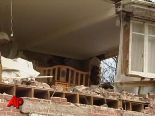 The earthquake that killed thousands in Nepal is a potent reminder of how important it is for a nation to adequately prepare for natural disasters – and experts warn that Israel’s infrastructure is solely lacking in this respect.
The earthquake that killed thousands in Nepal is a potent reminder of how important it is for a nation to adequately prepare for natural disasters – and experts warn that Israel’s infrastructure is solely lacking in this respect.
In the wake of the images of destruction and devastation coming out of Nepal, the question once again arises: What would have happened if an earthquake struck Israel today?
In 2011, the state comptroller released a report alerting on a possible disaster that could claim the lives of some 15,000 people and cause the collapse of hundreds of thousands of structures.
Over the past 1000 years, there were eight strong earthquakes in the area, most of them 6-6.6 on the Richter scale.
“They happened in a cycle of one every 100 years,” said Prof. Moshe Inbar, an expert on natural disasters from Haifa University. “These weren’t quakes like the one in Nepal, and still they claimed thousands of lives. In 1995 there was a 7-magnitude earthquake in the depths of the Dead Sea, over 100 km from Eilat, and the city still experienced damage. If such a quake hits inside the borders of the State of Israel, the damage could be much greater.”
The testimony of a resident of Tiberias from the earthquake that destroyed the city in 1837 paints a picture of the utter destruction previously experienced in the area.
“The ground moved under me. Pieces of rocks rolled down the mountains. Full of fear, I looked at the city below, where my most dear were – my husband and children. Dear God! I never got to see them again! I looked at the city walls, cracks created in them. Everything moved back and forth. I could not see a thing except for a thick and dark dust cloud that covered the entire city. Then, I heard a sound like thunder, and screams and cries of horror from the mouths of thousands.
“I fainted, falling to the ground. While the cracks in the city wall broke, panicked residents carrying some of their property, or their wounded relatives, or the body of a shattered man, also broke free. The entire city was in ruins. I worked all night to roll the rocks off the corpses of my children. My fingers were bloodied. No one helped me.”
The earthquake in Tiberias and Safed, which was 6.6-magnitude on the Richter scale, happened at 5 pm on Sunday, January 1, 1837.
A devastating earthquake in the region can only occur along the East African Rift, but it’s hard to predict the outcome of such a quake as the amount of damage depends on construction standards.
A construction bill meant to address to such a scenario was passed in 1980, but only started being enforced two years later.
According to the Construction Ministry, there are some 810,000 housing units that are not up to the standard set in the 1980 legislation.
“You can say anything built after that is okay,” Prof. Inbar explained. “The problem is there is older construction in areas and cities close to the East Africa Rift: In the lower areas of Tiberias, in Beit She’an, in areas of Safed not built on rocks, in Kiryat Shmona and of course in Eilat. The situation in Eilat is even more concerning because the hotels area is built on alluvium soil, the kind that increases Seismic waves.”
As terrifying as that sounds, Prof. Inbar is actually one of the optimists among the experts regarding the chances of rehabilitation following an earthquake, despite the devastating damage they leave behind.
Read more at YNET NEWS.
{Matzav.com Israel}











